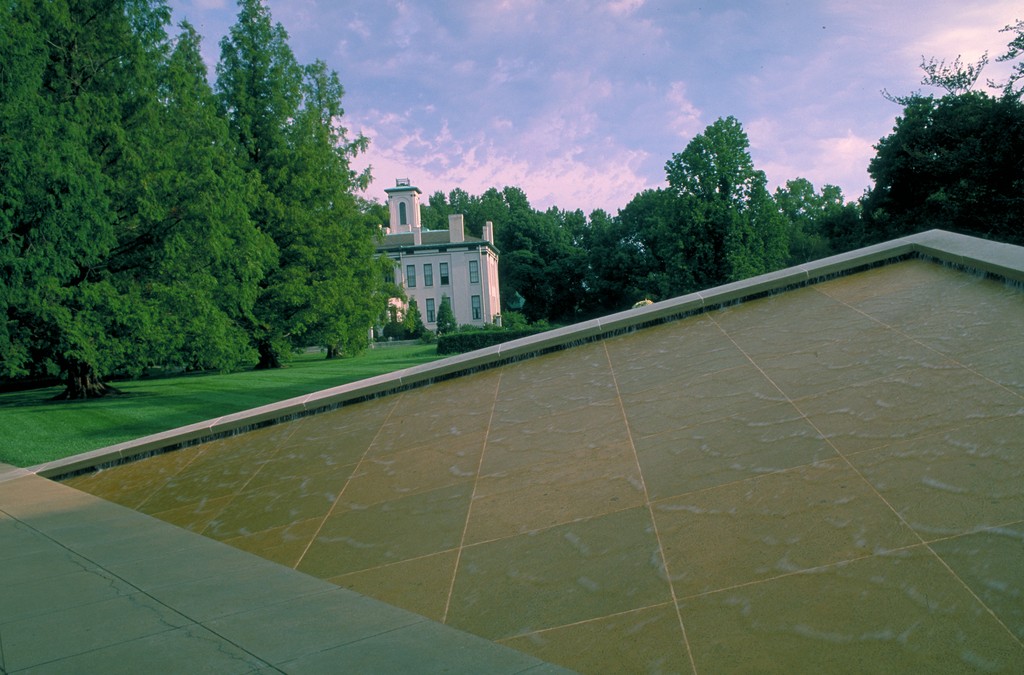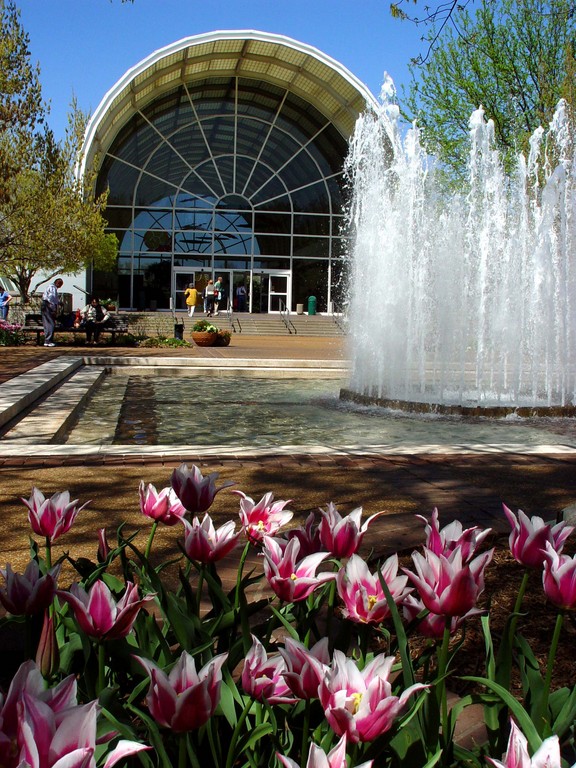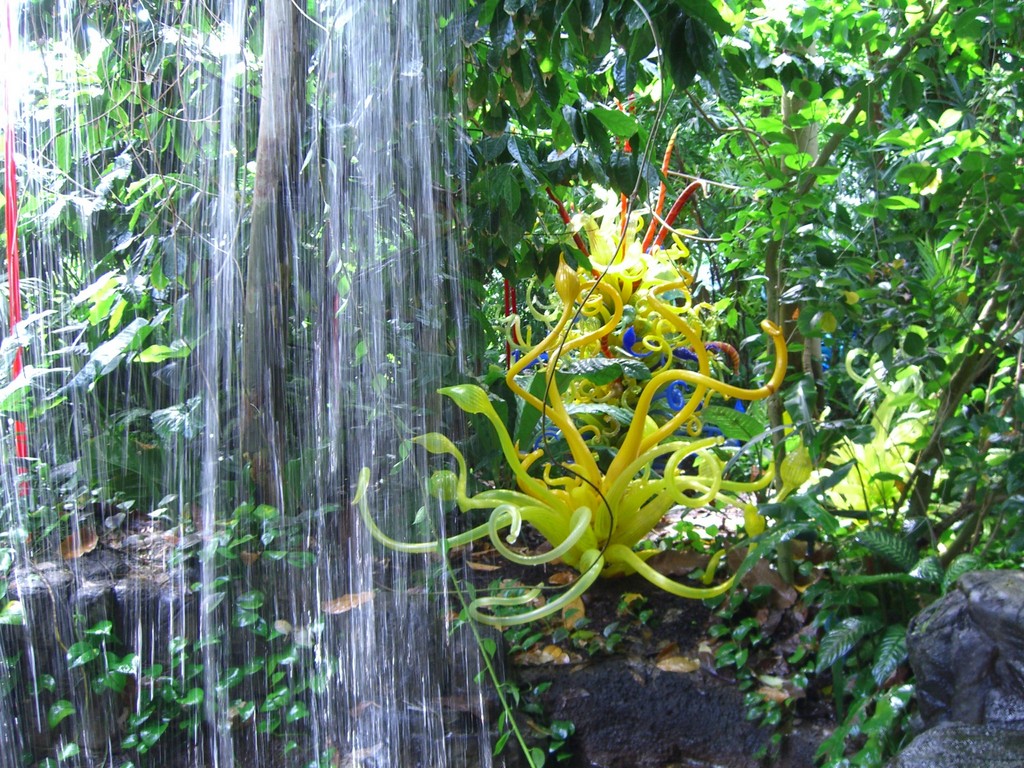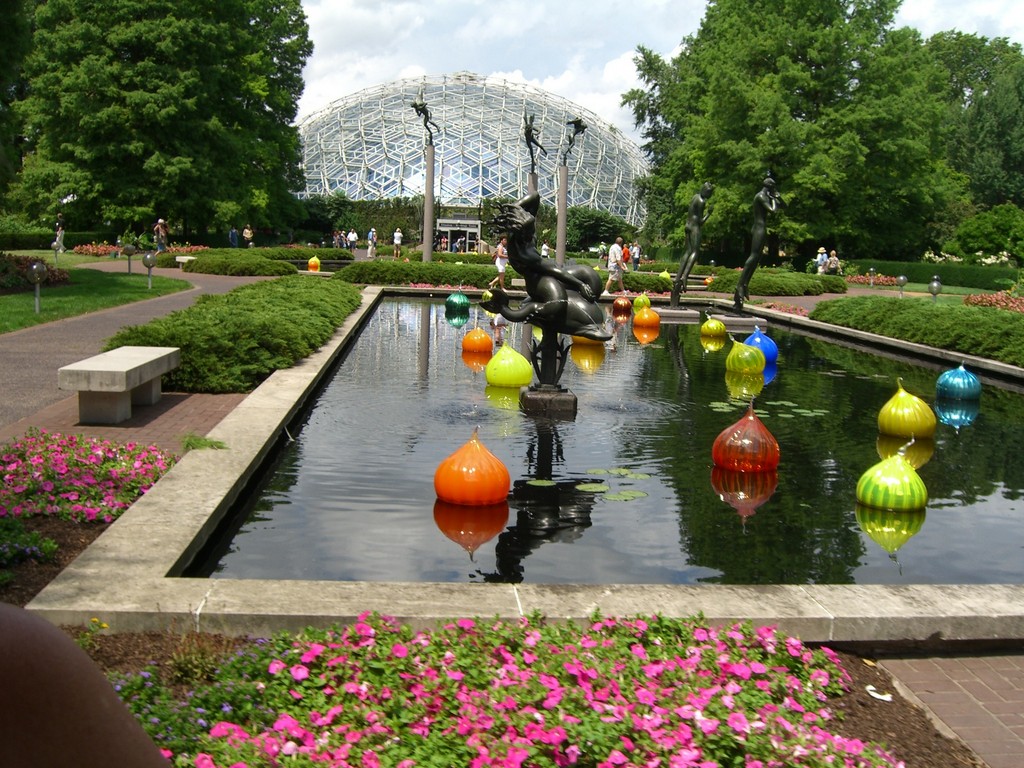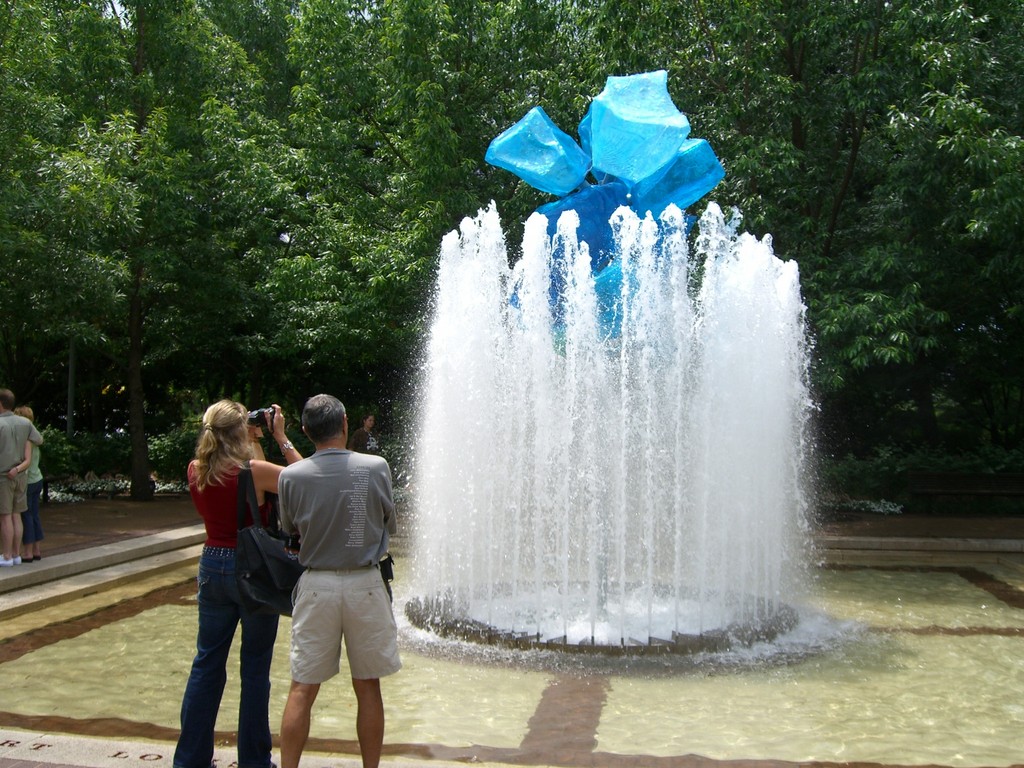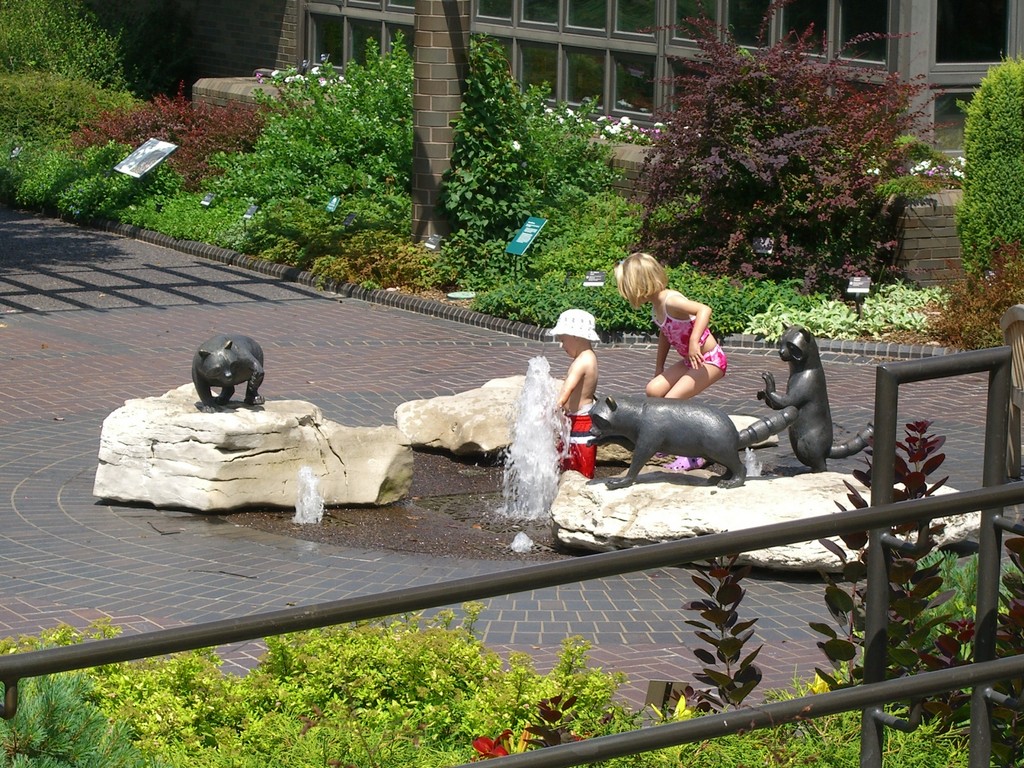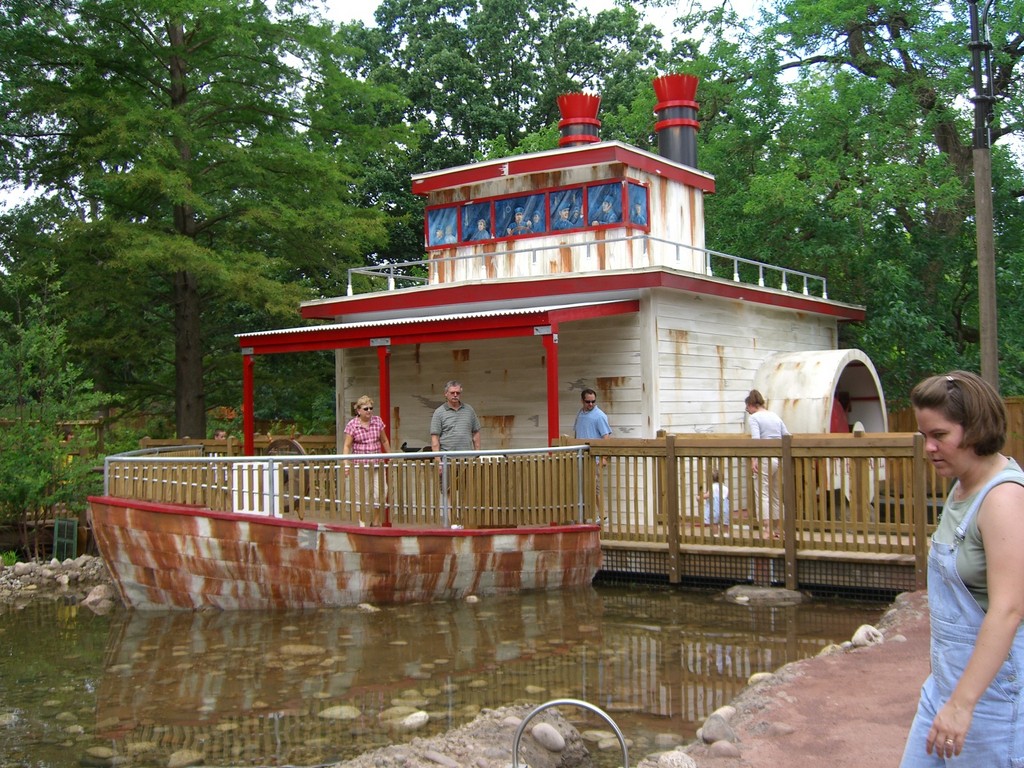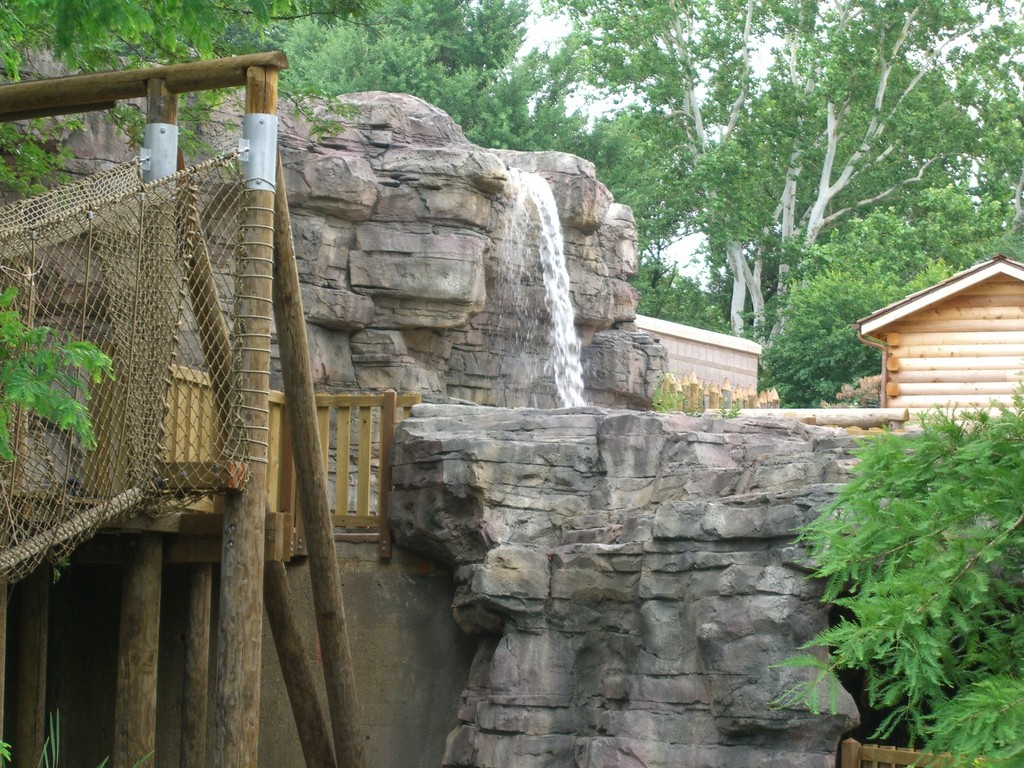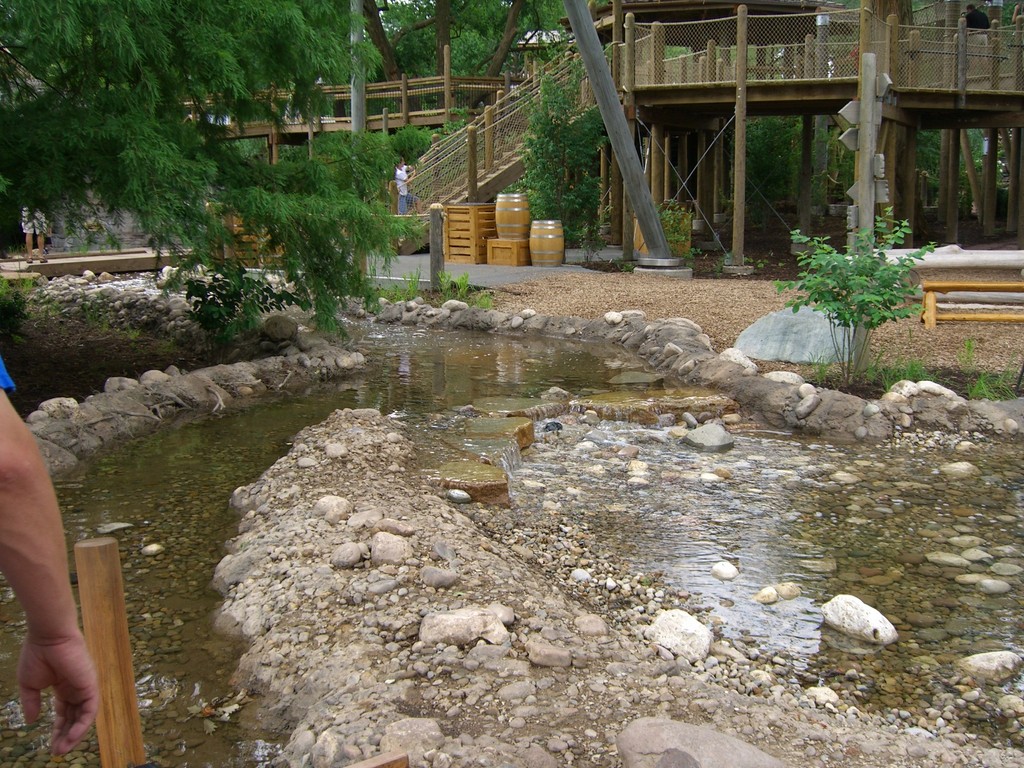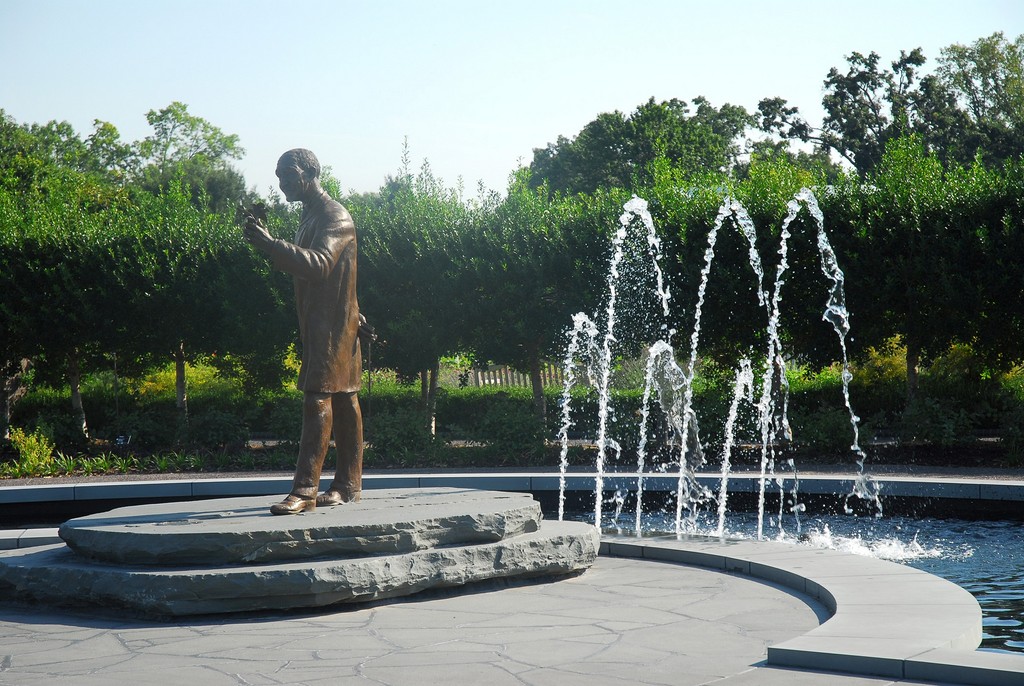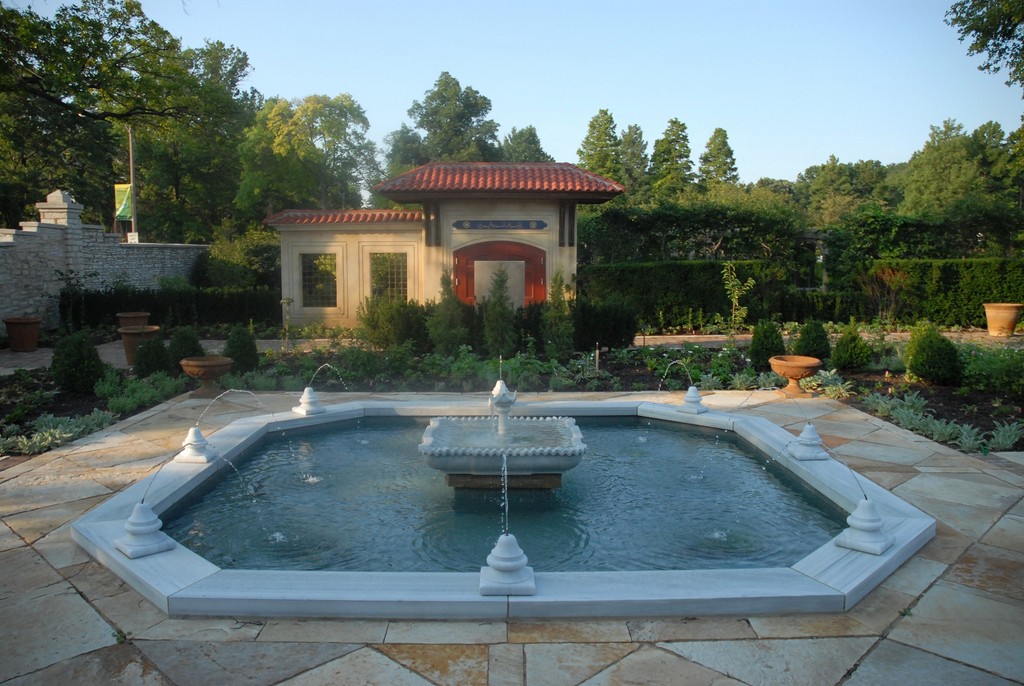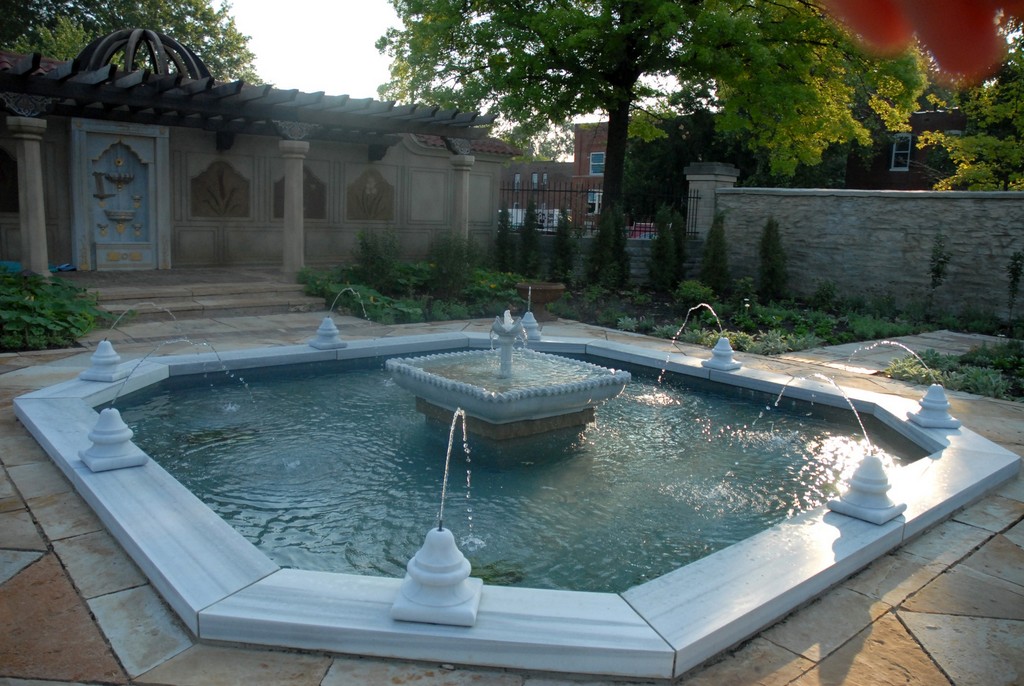Breathtaking Beauty
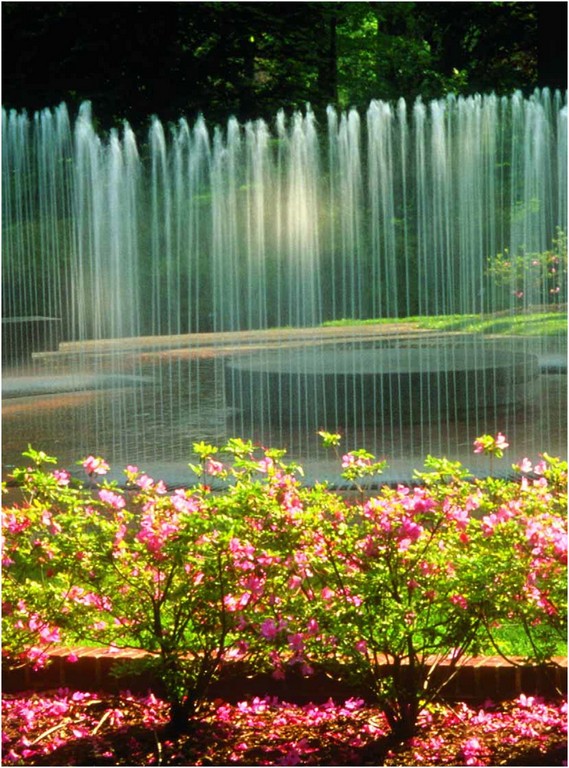
‘Any time that you can introduce water or the sound of water into an environment, the space is instantly transformed.’ – Geoffrey Lew Rausch, FASLA, 2006 recipient of the Henry Shaw Medal for his work at the Missouri Botanical Garden
During the past three decades, the Missouri Botanical Garden has undergone a wonderful transformation, and much of it has been about water.
In that span, more than a dozen fountains and waterfeatures have been added to the 79-acre grounds of what many have long been considered to be one of the top three public gardens in the world – and happily, our firm, Hydro Dramatics of St. Louis, has had the privilege of working on all of them as project leaders.
These installations have ranged from the simple to the complex. Whether serene or splashing, barely bubbling or shooting skyward, our work has added a unique spirit and drama to many already-beautiful sites. In addition, they’ve involved us in memorable collaborations with the garden’s creative staff, generous sponsors and the more than 850,000 people who come to the garden annually.
For our part, the diversity of the watershapes we’ve developed for our hometown’s pride and joy has given us the chance to explore and employ cutting-edge technology, work toward a number of specific programmatic goals and, perhaps best of all, observe the long-term reception our work has enjoyed among visitors of all ages – including our own children.
HISTORICAL ASSETS
Serene settings are often reciprocal: Even though you’re paying attention to a fountain or waterfall in a very public space, you experience very private moments as you sit or stand there, alone with your thoughts. By contrast, interactive spaces invite active and joyous participation, and children of all ages jump at the chance to jump, splash, play and cool off.
All of this – basically the totality of the way we relate to water – is encompassed by the Missouri Botanical Garden, where everything from contemplation to playful interaction has been encouraged and embraced.
| The Shapleigh fountain was our first project for the Missouri Botanical Garden. Back in 1974, its potential for interactivity made it an instant attraction and initiated a period (lasting to this day) in which watershapes of all sorts have regularly been added to the facility. |
Established in the 1850s by Henry Shaw, a prominent businessperson who made his fortune selling goods to Westward-bound traders and settlers in wagon-train days, the garden has long been a source of pride in St. Louis.
Inspired by the gardens of his native England, Shaw enlisted the eminent botanist, Dr. George Engelmann, to transform a treeless stretch of prairie into a garden showplace that was first opened to the public in 1859. By 1971, it had been designated as a National Historic Landmark and, under the direction of current president Dr. Peter Raven, has become a world-recognized center for botanical research, education and horticultural display.
Waterfeatures have always been a part of the Garden, but the governing entity’s interest in expanding the use of fountains and waterfalls as moving, audible focal points took a giant leap forward in 1974, with the opening of the Shapleigh Fountain – our company’s first project in the garden.
| A model of modernism, the Shoenberg Fountain was our second project in the gardens – and a technical challenge on several levels, not least of which was covering the entire, expansive surface with water in a way that made it seem effortless. |
Designed by the St. Louis-based architectural firm of Mackey Mitchell & Associates in collaboration with our design team, the Shapleigh Fountain is an interactive waterfeature that made its mark almost immediately – especially among children who flock to it when the weather turns warm.
During the construction process, we suggested design modifications, increased the fountain’s efficiency and fabricated and installed the components – restricted but significant involvement. And the results were and still are magnificent: With its ornamental grates set at ground level to disguise the fact that the fountain’s works are located just below grade, the Shapleigh Fountain is a total “fountain experience.” Visitors can pass through the fountain, wet or dry, to sit in the exact center where they are surrounded by a circular array of pulsing sprays that shoot up in stages to a height of eight feet.
On sunny days, this fountain is magical, with multiple rainbows dancing in its sprays as a mesmerizing visual treat. And its overnight popularity opened a door: Once it took its place as an attraction, the momentum toward water displays was irresistible.
SIGNATURE FEATURES
With the Shapleigh Fountain on line, landscape designer Geoffrey Rausch and the principles at Mackey Mitchell approached us to provide equipment for another watershape, the Shoenberg Fountain – an altogether different design concept.
This thoroughly contemporary fountain confronts visitors with a large slab of smooth, angled concrete topped by a sheet of flowing water that ripples silently down the fountain’s face before disappearing at the bottom. The challenge here was equipping the system to achieve a sense of effortlessness – this despite the fact we were pumping water at a steep angle, reclaiming it under the sidewalk and moving it rapidly back to the top of the slab to renew the cycle.
| Standing opposite the main entrance to the Missouri Botanical Garden, the Latzer Fountain has become the facility’s icon – a backdrop for weddings and family portraits all year ’round. It’s also available for special uses, as seen in the sidebar just below. |
From there, we moved on to the Latzer Fountain in 1982, perhaps the most prominent of all the garden’s watershapes. A popular and dramatic backdrop for weddings and family and group photographs, it basically serves as the garden’s “goodwill ambassador,” greeting visitors when they first enter the facility through the Ridgway Center.
In many ways, this was the most challenging of all our garden projects. During the design stage, we worked closely with Rausch, who thought it important to make the fountain multi-seasonal and spectacular because it would be the first feature visitors would see in entering the space. He wanted the fountain to offer, as he put it, “a distinct, celebratory effect.”
We worked carefully with him both to simplify and modernize the original design, but we faced a conundrum: How could we maximize the fountain’s dramatic potential yet manage water sprays that might utterly drench passersby when winds kicked up?
|
Artistry in Glass As this article reaches print, the Latzer Fountain is approaching its last month as host to an outstanding exhibition: For the past few months and through to the end of January 2007, the fountain has been the setting for a huge glass sculpture that’s part of a major, garden-wide installation by renowned Seattle glass artist Dale Chihuly. The installation and integration of the Chihuly piece – a contemporary, cubical, translucent-glass sculpture reminiscent of floating ice cubes – into the fountain system required intense cooperation and synchronization.
To allow the exhibit installers and garden staff to work without any extra difficulty, we completely shut down the fountain system. Once the glass sculpture was in place, we powered up the fountain in small increments, increasing the water flow gradually until we reached what everyone agreed was the critical height for maximum aesthetic value. The result – especially when lit at night – is incredibly dramatic. Such good things must come to an end, and we know already that removing the sculpture when the exhibit ends will undoubtedly require another careful team effort. — K.F. |
Through our collaboration, we came up with the idea of deploying special wind sensors that would shut down the fountain’s 10-inch feed pipe whenever the wind blew at more than ten miles an hour. The shutdown would in turn trigger a single, large geyser from the fountain’s center, thus maintaining a fountain effect without soaking visitors. We also suggested incorporating a basin into the design to provide an attractive seating area when the fountain had to be turned off.
Another Latzer Fountain challenge had to do with developing a system in which all working elements could be placed underground, including plumbing, pipes and the equipment involved in raising and lowering individual sprays. Our successes here produced a stunning and practical fountain. What’s more, as trees grew in around the perimeter of the plaza, they provided a natural windbreak: Today, the fountain can function fully – no matter how windy the day – without any risk of drenching those who come to enjoy it.
COMPLEX JETS
In subsequent years, thoughts turned from display fountains to those with a more interactive stamp.
One of the earliest efforts along these lines had to do with creation of the “Leaping Frog” fountain in 1996. Located within the Ruth Palmer Boxwood Garden, this watershape uses a form of jumping-jet technology that was both a bit ahead of its time and extremely difficult to engineer and manufacture.
| The swing toward fully interactive fountains started with the installation of the ‘Leaping Frog’ Fountain in 1996. This project’s laminar-flow jumping jets were a bit ahead of their time and required an awesome amount of engineering and testing to get things right. |
The challenge for our design manager, Dan Heinlein, entailed working with laminar jets that had to be set with arcs of certain degrees to achieve optimum water flow. Calculating this required mathematical preparation, plentiful drawings and empirical observation of models and test versions.
The result of this careful design development was an interactive fountain that sends silvery, well-defined “ropes” of water hurtling ten feet across walkways in crisscross patterns that create a visual archway. It seems to shoot up only from one end, but that impression is actually built using two separate half-arcs.
The garden’s exploration of interactive waterfeatures actually began in the late 1980s, when groups of animal sculptures were visualized among a range of playful sprays. At that time, noted Missouri artist Robert Lee Walker was commissioned to create bronzes for the William T. Kemper Center for Home Gardening. Determining how to add water to these popular sculptures was actually quite easy compared to some of our other work at he facility, but it was quite rewarding just the same.
| We’ve worked water into a number of small displays related to animal sculptures that have appeared in the gardens during the past 30 years – including the wonderfully interactive ‘Three Playful Raccoons’ fountain, shown here. |
Again taking charge as project manager, Heinlein built mock-ups and prototypes for the various planned sculptures and was instrumental in designing copper-tubing elements that Walker built into some of the sculptures. In his “Three Playful Raccoons” fountain, we brought water into a highly interactive area while hiding all of the fountain components under the large, circular grate in a brick plaza. To achieve optimum effects, we included leveler controls, a submersible pump to recirculate the water and separate valves and nozzles for each smaller fountain – all driven by a single pump.
We also added water to the “Four Playful Otters with Fish” fountain as well as the “Three Dancing Geese” and “Six Dancing Geese” fountains and the “Two Playful Peacocks” fountain. The latter had to have its plumbing integrated into the sculpture as Walker was forming it – more than a dozen nozzles in all.
RECENT ARRIVALS
By the late ’90s, we were old hands at working on waterfeatures for the Missouri Botanical Garden, and in 2006 we played an integral role in providing three new waterfeatures for the public to enjoy.
Among newer fountains is a system located in the Doris I. Schnuck Children’s Garden. Titled “A Missouri Adventure,” this watershape takes the facility in an all-new direction by providing children with an interactive opportunity to explore 19th-century life along the river. Among the prominent watershapes we installed in this two-acre space is a popular cooling/splash area complete with “popper” jet fountains and a mushroom pump.
| ‘A Missouri Adventure’ took watershaping for the garden to a new level, with a display dedicated to introducing children to life on the rivers that cut through St. Louis. All the controls for the various play fixtures, waterfalls and streambeds are contained in the wheelhouse – equipment, controls, filters and more. |
We arranged all pumping and control systems for these watershapes in a single pump house designed to resemble a paddle wheel and also supplied all the necessary equipment, controls, filters and chemical systems for the space’s dazzling waterfall.
In addition, we worked on the watershapes in the George Washington Carver Garden, a fitting tribute to the renowned educator and prolific agricultural researcher. In this acre-and-a-half space, the focal point is a life-size bronze statue located on a walking bridge between two fountains and a reflecting pool.
| George Washington Carver is memorialized in a large acre-and-a-half space, complete with two fountains and a reflecting pool. |
At the request of the garden staff and in keeping with the overall design, we installed all of the fountain equipment underwater instead of at a remote location or an underground vault. This approach has been favored in the garden for years – so much so that it’s a tradition we didn’t even question.
Then there is the Ottoman Garden, a unique quarter-acre garden devoted to the Islamic design sensibility as expressed during the long tenure of the Ottoman Empire. Here we installed a traditional fountain – a selesibil – in which water drips down the tiers of a wall to create a pleasing, relaxing experience. The garden’s focal point is a shallow pool with jets spouting gently along the rim – another classic design.
One of the challenges we faced in adding these new waterfeatures had to do with the fact that the general area also encompasses the Swift Family Garden and the Isabelle A. Baer Garden – spaces that already had watershapes and equipment arrays into which we had to integrate the new technologies that were to drive ours. After a thorough study of all of the elevations that were to be affected (as well as a careful review of the designer’s intent), we were able to develop a one-for-all control system.
WATER ADDED
Our lengthening collaboration with the Missouri Botanical Garden has been beneficial all the way around, making the facility more attractive and fun for its visitors while enabling us to radiate our expertise and the technologies we’ve developed to other projects and clients. The submersible pumps and filters we created for the garden, for example, proved equally applicable to the beautiful watershapes at the Chicago Botanic Garden in Glencoe, Ill., as well as in many other projects across the United States and throughout the world.
| In addition to fanciful projects with lots of interactivity, we’ve also worked with classic forms, as in the Ottoman Garden. Here, we developed a simple octagonal fountain in the Islamic style, with small arcing sprays. On the wall behind, we set up a traditional, tiered fountain – all simple but effective. |
Through our collaborations and by adding water to these important public spaces, we’ve been able to enhance the experiences of tens of thousands of visitors who use these spaces on a daily basis. The fact that it all started on the grounds of one of our hometown’s main points of pride has made it all special – and it hasn’t bothered any of us one bit that we ourselves are among the visitors who get to enjoy the facility on a regular basis with our parents and children.
Kerry Friedman is vice president and general manager for Hydro Dramatics, a St. Louis-based fountain-consulting and -design firm and division of Missouri Machinery & Engineering Co. A veteran of the water-pumping and hydraulics industries since 1971, Friedman has applied his expertise to a vast number of projects nationwide and across the globe, including the company’s work on the East St. Louis Riverfront fountain, known as the world’s tallest vertical jet system. He has been integral in a range of similarly ambitious projects, including Plaza Minillas in San Juan, P.R.; Weil University in Doha, Qatar; and the U.S. Embassy in Moscow.













